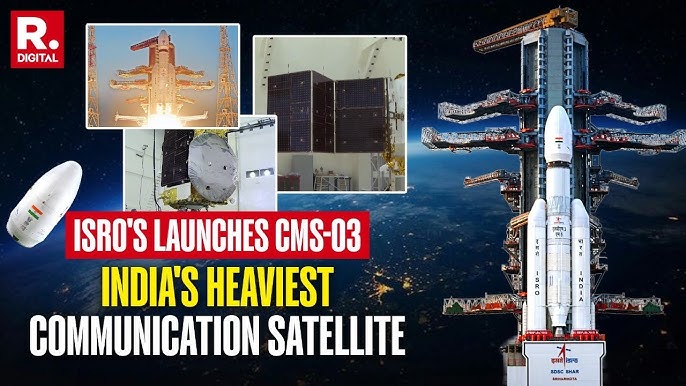02-11-2025 Satish Dhawan Space Centre (SDSC) SHAR, Sriharikota.
The Indian Space Research Organisation (ISRO) achieved a momentous success with the launch of its heaviest-ever communication satellite, CMS-03, on Sunday, November 2, 2025, at 5:26 pm IST. The mission, designated as LVM3-M5, took off flawlessly from the Second Launch Pad at the Satish Dhawan Space Centre (SDSC) SHAR, Sriharikota. This mission marked the fifth operational flight of the heavy-lift launch vehicle, the Launch Vehicle Mark-3 (LVM3), popularly nicknamed ‘Bahubali’.
The CMS-03 satellite, weighing an impressive 4,410 kg, became the heaviest communication satellite ever launched from Indian soil into the Geosynchronous Transfer Orbit (GTO). This achievement underscores India’s rapidly maturing capabilities in independently handling heavy payloads, a segment where ISRO previously relied on foreign launch providers for satellites over 4,000 kg.
The LVM3-M5 rocket, standing 43.5 metres tall with a lift-off mass of 642 tonnes, performed its multi-stage flight sequence precisely. After a flight duration of approximately 16 minutes, the rocket successfully injected the CMS-03 into its highly elliptical Geosynchronous Transfer Orbit (GTO) at an altitude of approximately 179.8 km. The satellite, also known as GSAT-7R (a replacement for the GSAT-7 satellite), will subsequently use its onboard propulsion system to maneuver into its final geostationary orbit, about 36,000 km from Earth.
The CMS-03 is a multi-band communication satellite designed to provide critical services across C, extended C, and Ku bands. This advanced platform is set to significantly enhance India’s space-based communication network. The satellite carries immense strategic significance, as it is primarily dedicated to strengthening the Indian Navy’s secure, multi-band military communication and improving their maritime domain awareness across the vast Indian Ocean Region. Beyond defence, it will also boost digital connectivity and provide enhanced bandwidth for civilian applications, disaster management, and improving digital access to remote territories of India.
ISRO Chairman, V Narayanan, congratulated the team on the successful mission, stating, “LVM3-M5 successfully injected into the required orbit precisely. This is the 8th consecutive successful launch by LVM3. CMS-03 is the heaviest satellite placed in GTO orbit. The vehicle performance was enhanced to increase its payload capacity by 10%.” He also highlighted the new technology in the satellite, which has a life of 15 years, and noted that “The launch also had the reignition of C20 cryogenic engine for the first time after placing the satellite,” demonstrating further technological prowess.
The successful launch was lauded by national leaders and the Indian space industry. Prime Minister Narendra Modi, in a post on social media, congratulated ISRO, writing: “Our space sector continues to make us proud! Congratulations ISRO on the successful launch of India’s heaviest communication satellite, CMS-03. Powered by our space scientists, it is commendable how our space sector has become synonymous with excellence and innovation.” Industry bodies also congratulated ISRO, with the Director General of the Indian Space Association calling it “a monumental achievement for India, powerfully demonstrating our sovereign capability in launching heavy-payload satellites for strategic applications.” The successful mission is also seen as a major confidence booster for the upcoming Gaganyaan human spaceflight program, for which a modified LVM3 rocket will be used.




